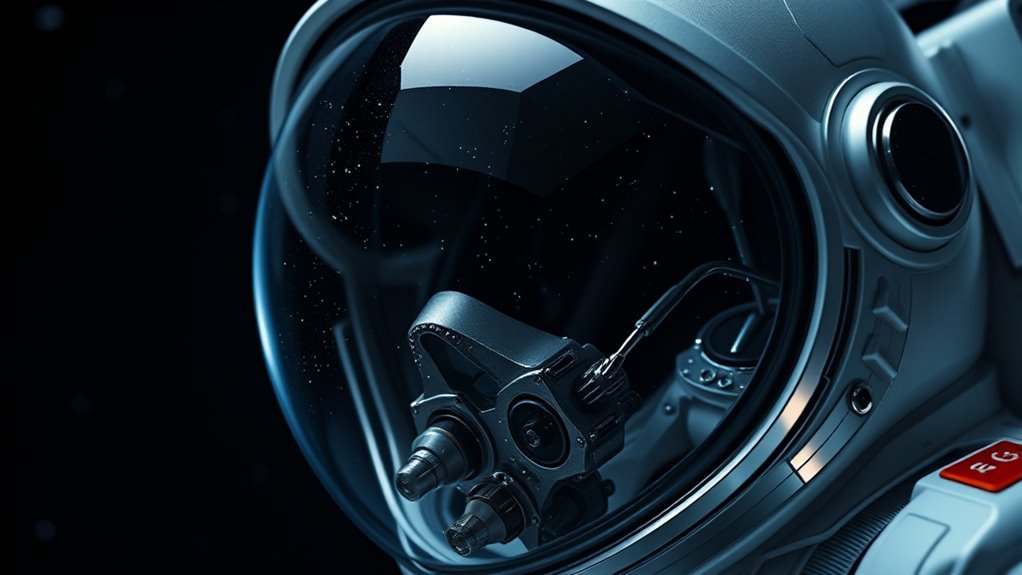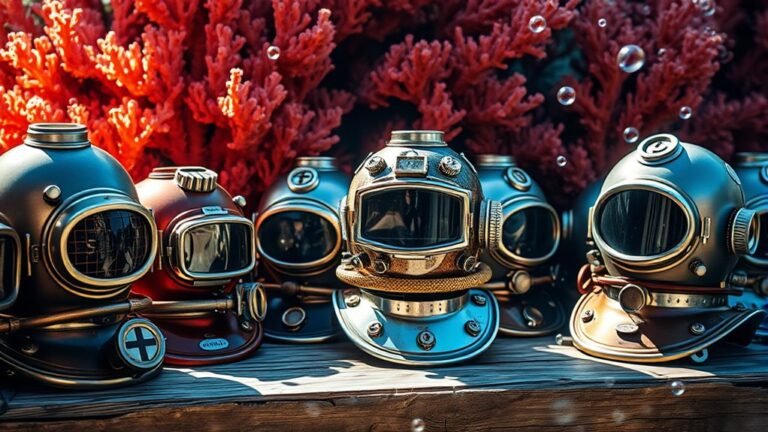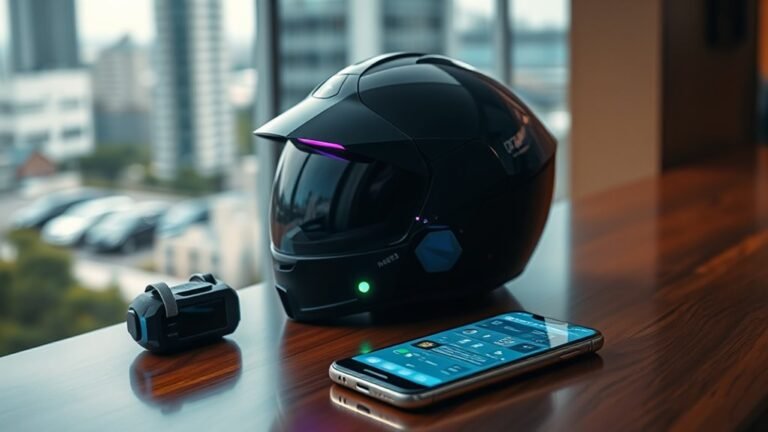Space Helmets: How They Work in Zero Gravity
Space helmets are engineered to provide essential life support and protection in zero gravity. They maintain pressure, supply breathable oxygen, and manage temperature extremes with integrated systems. Advanced materials guarantee durability while lightweight designs promote mobility. Communication systems facilitate coordination with your team, and visors enhance visibility while shielding your eyes from harmful radiation. They also manage carbon dioxide levels, guaranteeing a safe environment. Discover how these features work together to enhance your mission in space.
The Importance of Space Helmets
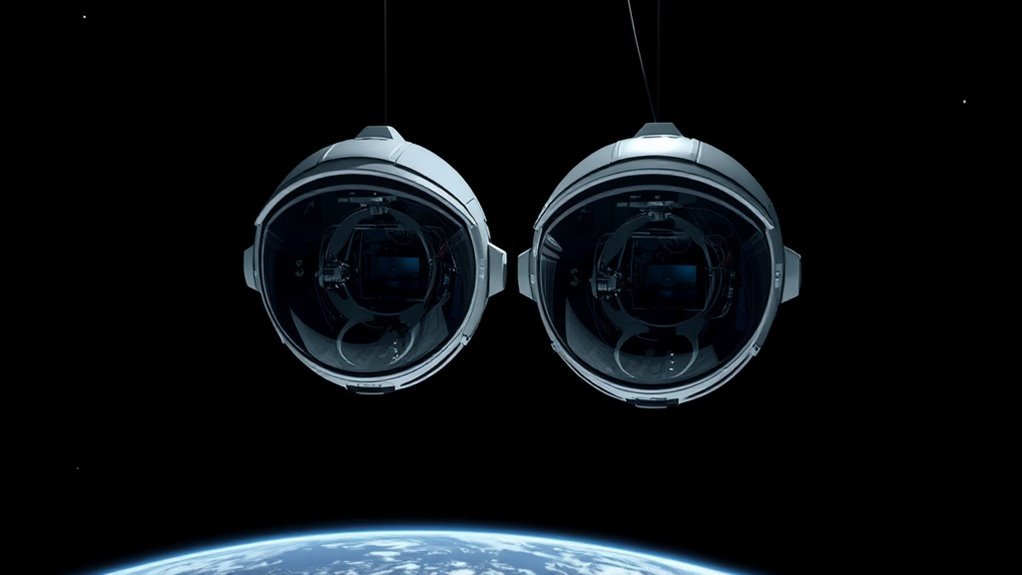
While you may not think about it often, the importance of space helmets in zero gravity cannot be overstated. These helmets are essential for astronaut safety during space exploration, serving multiple vital functions. They provide a controlled environment, maintaining pressure and supplying oxygen, critical in the vacuum of space. Additionally, they protect against harmful radiation and micrometeoroid impacts, ensuring that you can focus on your mission without distraction. The helmet’s visor shields your eyes from intense sunlight and debris, enhancing visibility. Furthermore, integrated communication systems allow seamless coordination with your team. Fundamentally, space helmets not only enable survival but empower astronauts to explore the cosmos, reflecting humanity’s desire for freedom and discovery beyond our planet.
Key Components of a Space Helmet
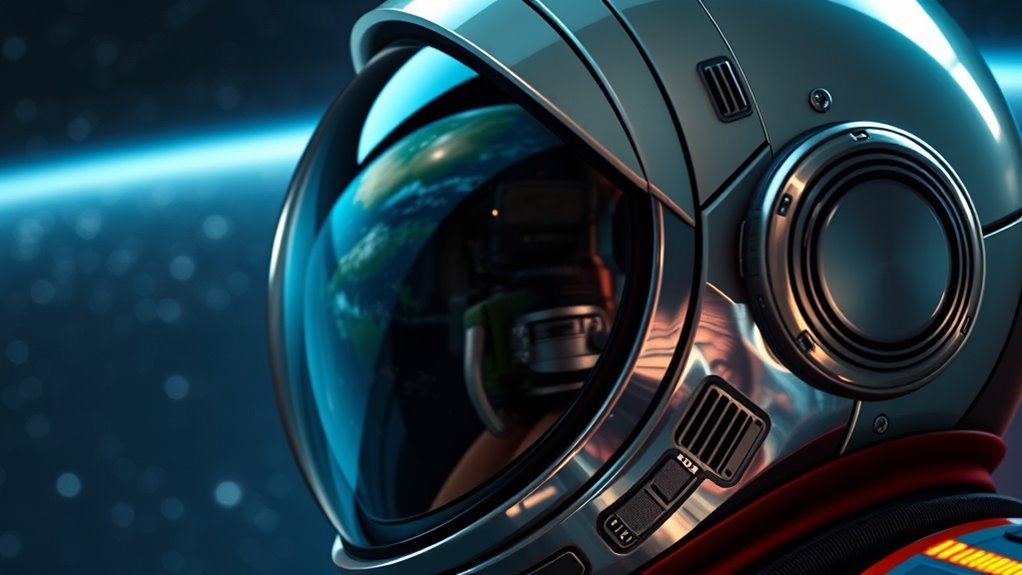
A space helmet is a complex assembly of essential components designed to secure astronaut safety and functionality in the harsh environment of space. The material composition of the helmet plays a significant role in its effectiveness; advanced polymers and carbon fiber are often used for structural integrity and weight reduction. Inside, a life support system guarantees a breathable atmosphere, while a communication device facilitates contact with the spacecraft and crew. Helmet sizing is critical; it must fit snugly to prevent any movement that could compromise seals and safety. Additionally, the visor incorporates anti-fog and anti-scratch coatings, enhancing visibility. Each component is meticulously engineered to balance protection with the freedom of movement, allowing astronauts to perform their tasks efficiently in zero gravity.
Protection Against Vacuum and Temperature Extremes
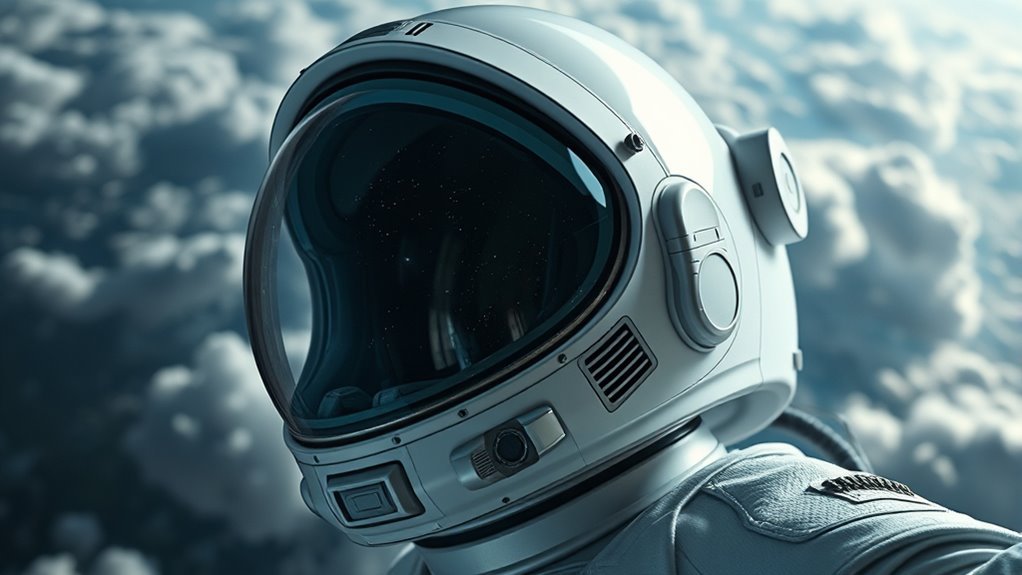
Because space presents a vacuum and extreme temperature fluctuations, space helmets must be engineered to withstand these harsh conditions. You’ll find that effective vacuum insulation is critical; it prevents heat transfer and protects you from the cold of space. The materials used, such as multilayer insulation, minimize conductive and radiative heat loss, ensuring your comfort and safety. Temperature regulation systems are also integrated into the helmet, maintaining a stable internal environment. This includes thermal control layers that help manage heat generated by your body and external conditions. By ensuring these systems work in harmony, your helmet provides the necessary protection against the rigors of space, allowing you to navigate freely without the fear of temperature extremes or vacuum exposure.
Life Support Systems Integrated Into Helmets
Space helmets are equipped with sophisticated life support systems that guarantee astronauts can breathe and function effectively in the hostile environment of space. These systems feature advanced helmet integration to secure peak performance. Key components include:
Space helmets integrate advanced life support systems, ensuring astronauts can breathe and thrive in the harshness of space.
- Oxygen Supply: Provides a continuous flow of breathable oxygen.
- Carbon Dioxide Removal: Filters out exhaled CO2 to prevent toxicity.
- Temperature Regulation: Maintains a stable internal temperature through thermal control.
- Humidity Control: Manages moisture levels to promote comfort and prevent visor fogging.
Together, these elements create a seamless life support experience, allowing you to focus on tasks without worrying about survival. Understanding these systems is essential for appreciating how space helmets empower astronauts in their quest for exploration and discovery.
Communication Systems for Astronauts
While operating in the vastness of space, effective communication is essential for astronauts to coordinate with mission control and each other. Space helmets are equipped with advanced communication systems that utilize specific communication protocols to guarantee seamless interaction. These protocols manage the transmission of audio signals, minimizing latency and maximizing audio clarity. In a zero-gravity environment, sound travels differently, so astronauts rely on these systems to filter background noise and enhance voice recognition. The helmets incorporate noise-canceling microphones and speakers that adjust to varying conditions, assuring that critical messages are conveyed without distortion. By leveraging these technologies, astronauts can maintain clear lines of communication, fostering collaboration and enhancing mission success while maneuvering the challenges of space exploration.
The Role of Visors in Visibility and Protection
Visors are critical components of space helmets, primarily designed to enhance visibility while providing essential protection. They incorporate UV protection features to safeguard against harmful solar radiation, along with anti-fog technology that guarantees a clear view in varying temperatures. Additionally, visors are engineered to maintain visibility in darkness, allowing astronauts to operate effectively in low-light conditions.
UV Protection Features
As astronauts navigate the harsh conditions of outer space, the importance of UV protection becomes paramount, particularly through the use of specialized visors. These visors not only enhance visibility but also shield you from harmful solar radiation. Here’s how they contribute to your safety:
- Advanced UV Protection Materials: They’re engineered to block a significant percentage of UV radiation.
- Multi-layer Construction: This enhances helmet durability while providing effective protection.
- Anti-reflective Coatings: These minimize glare, improving visibility in bright conditions.
- Tinted Options: You can choose different tints to optimize your visual comfort based on mission requirements.
With these features, the visors in your helmet guarantee you remain protected and can focus on the mission ahead without worrying about UV exposure.
Anti-Fog Technology
In the vacuum of space, maintaining clear visibility is as vital as UV protection. Anti-fog technology plays a significant role in guaranteeing your visor remains free from condensation, which could obscure your view. Utilizing advanced anti-fog coatings, these visors effectively manage moisture, preventing fog build-up during varying temperature changes.
| Feature | Description |
|---|---|
| Anti-Fog Coatings | Specialized layers to reduce fogging |
| Moisture Management | Systems designed to control humidity |
| Temperature Regulation | Maintains visor clarity across extremes |
| Visibility Assurance | Guarantees unobstructed sight in all conditions |
This combination of coatings and management techniques keeps the visor clear, allowing you to focus on your mission without distraction.
Visibility in Darkness
How can astronauts effectively navigate the pitch-black expanses of space? The visors on their helmets play an essential role in darkness navigation and visibility enhancement. Here’s how they work:
- Anti-Reflective Coating: Reduces glare, allowing clearer vision in varying light conditions.
- Tinted Visors: Protects against intense sunlight while improving contrast and depth perception.
- Integrated Lighting: Some visors have built-in lights for illuminating surroundings without losing night vision.
- UV Protection: Shields eyes from harmful radiation, ensuring long-term eye health.
These features not only enhance visibility in darkness but also protect astronauts from potential hazards, allowing for safe exploration of space’s shadowy regions. The design of these visors demonstrates the balance between functionality and safety in extreme environments.
How Helmets Manage Carbon Dioxide and Oxygen Levels
While space helmets are primarily designed for protection, they also play an essential role in managing the astronaut’s respiratory environment. Effective carbon dioxide management is imperative. These helmets contain systems that actively monitor CO2 levels, guaranteeing they remain within safe limits. When CO2 concentration rises, the helmet’s built-in scrubbers utilize chemical processes to remove excess gas, preventing toxicity. Additionally, oxygen recycling systems are integrated to optimize the astronaut’s oxygen supply. They capture exhaled oxygen, purifying and reintroducing it into the breathing mix. This closed-loop system not only enhances safety but also supports long-duration missions by conserving resources. By maintaining equilibrium of carbon dioxide and oxygen, helmets guarantee that you can breathe easily, even in the harshest conditions of space.
Suit Design and Mobility in Zero Gravity
Space helmets, with their sophisticated life-support systems, set the stage for understanding the overall design of space suits, particularly regarding mobility in zero gravity. You’ll encounter several mobility challenges that designers must address to guarantee your freedom of movement, including:
- Joint articulation: Suits need flexible joints to allow natural movement.
- Material selection: Lightweight, durable fabrics enhance suit flexibility without sacrificing protection.
- Pressure regulation: Maintaining proper pressure while enabling movement is essential for comfort.
- Mobility aids: Incorporating support devices can assist in maneuvering zero gravity.
The Future of Space Helmet Technology
As advancements in technology continue to reshape our understanding of human exploration beyond Earth, the future of space helmet design is poised for significant transformation. You’ll likely see helmets made from advanced materials, providing enhanced durability and lightweight benefits. This will not only improve comfort but also safety during your missions. Moreover, helmet customization may allow for personalized features, such as augmented reality displays, tailored oxygen delivery systems, or even climate control, catering to individual needs.
| Feature | Current Technology | Future Innovations |
|---|---|---|
| Material | Standard composites | Advanced lightweight alloys |
| Customization | Limited options | Fully customizable interfaces |
| Communication | Basic audio systems | Integrated AI assistants |
| Safety Features | Standard visors | Enhanced impact resistance |
Embracing these innovations will enhance your freedom in space exploration.
Frequently Asked Questions
How Much Does a Space Helmet Weigh in Zero Gravity?
In zero gravity, a space helmet’s weight perception changes due to buoyancy effects, making it feel almost weightless. While the actual weight remains the same—typically around 3 to 5 pounds—the lack of gravitational force means you won’t experience it as you would on Earth. This altered perception allows you to maneuver more freely, but you still need to take into account the helmet’s structural integrity and functionality within the vacuum of space.
Can Astronauts Customize Their Space Helmets?
You might think astronauts can jazz up their helmets like a fashion statement, but it’s not quite that simple. While they can express some preferences, modifications are tightly regulated for safety. Astronauts can request specific features, like sun visors or communication systems, but can’t go wild with customization. The design prioritizes functionality, ensuring peak performance in the harshness of space, so you won’t see them sporting glittery decals anytime soon.
What Materials Are Space Helmets Made From?
Space helmets are primarily made from advanced materials like polycarbonate, Kevlar, and specialized fabrics. These materials are chosen for their lightweight, durability, and ability to withstand extreme temperatures. In a materials comparison, polycarbonate provides excellent visibility while Kevlar offers protection against impacts. The integration of cutting-edge helmet technology, including thermal insulation and communication systems, guarantees safety and performance, allowing you the freedom to focus on your mission without worrying about your protective gear.
How Often Are Space Helmets Inspected and Maintained?
You’d think space helmets get a leisurely life, but they actually undergo rigorous inspection protocols. Typically, you’ll find that helmets are inspected before every mission and maintained regularly, often every few months or after significant use. This maintenance frequency guarantees that every component functions flawlessly in the harsh vacuum of space. It’s ironic, really—these advanced pieces of technology need meticulous care to protect your freedom to explore the cosmos!
Are Space Helmets Compatible With Different Space Suits?
Yes, space helmets are designed for compatibility with various space suits, guaranteeing ideal suit integration. Each helmet must meet specific standards to function effectively with its corresponding suit, providing essential life support and protection. Manufacturers rigorously test helmet compatibility to guarantee they work seamlessly, preserving astronaut safety and mobility. When you’re selecting a helmet, consider its design and features to assure it enhances your overall space suit experience without compromising functionality or comfort.
